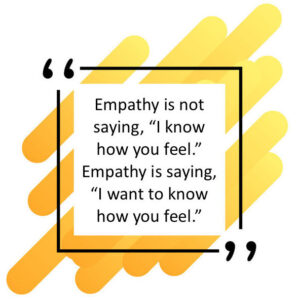
Kris English, PhD
Professor Emeritus of Audiology
The University of Akron
Not to worry: the title above looks like a typo, but is actually a kind of mantra to help us find and maintain what is being called clinician presence during patient encounters:1
- NOW. I am not distracted / I am fully focused on the moment.
- HERE. I am aware of how this space and consultation affects my patient.
- THIS. I am fully attending to this patient’s unique narrative.
 “Clinician presence” may not be familiar to student trainees, but working with the concept might help them recognize the impact we have on patient impressions and patient outcomes. Clinician presence is defined as a “purposeful practice of awareness, focus, and attention with the intent to understand and connect” (emphasis added) with our patient. Core elements include familiar person/patient-centered behaviors and attributes:2
“Clinician presence” may not be familiar to student trainees, but working with the concept might help them recognize the impact we have on patient impressions and patient outcomes. Clinician presence is defined as a “purposeful practice of awareness, focus, and attention with the intent to understand and connect” (emphasis added) with our patient. Core elements include familiar person/patient-centered behaviors and attributes:2
- Listening without interrupting
- Finding out what the patient cares about
- Exploring emotional cues (noticing, naming, validating)
- Humility 3,4 (i.e., no matter how many patients we’ve served, we don’t know what this patient will say or need)
- Signposting before note-taking (stepping away from Now.Here.This. as needed)
The “intent to connect” adds an important relational dimension to person-centered care, reminiscent of the Relationship-Centered Care model.5,6 Sustaining clinician presence involves mental and emotional labor7 so taking brief re-centering breaks throughout the day is recommended. That said, it’s encouraging to know that relational communication has been associated with reducing burnout.8
Conclusion
Because of its brevity, this mantra could serve as a nonthreatening framework for in-depth student discussions. (For example: What does “Now.Here.This.” bring to mind? Would this kind of focus support patient trust? How is patient trust related to healthcare decisions? How would a patient describe their audiology experience?) Trainees may be surprised to learn how important they are, beyond the role of collecting case histories and test data. If we are responsible for student development, we can nurture this growth by routinely asking them, “Did it feel like you connected with your patient today?”

References
- Brown-Johnson C. et al (2019). What is clinician presence? A qualitative interview study comparing physician and non-physician insights about practices of human connection. BMJ Open, 9, e0308831
- Zulman et al. (2020). Practices to foster physician presence and connection with patients in the clinical encounter. JAMA, 323(1), 70-81.
- Huynh HP et al. (2021). What do humble doctors do? A conceptualization of clinician humility from the patient’s perspective. Patient Education and Counseling, 104, 3066-3071.
- Wadwa A, Mahant S. (2022). Humility in medical practice: A qualitative study of peer-nominated excellent clinicians. BMC Medical Education, 22, 88.
- Maitra A. et al. (2021). Using ethnographic methods to classify the human experience in medicine: a case study of the presence ontology. Journal of the American Medical Informatics Association, 28(9), 1900–1909.
- Tresolini C. et al. (2000). Health professions education and relationship-centered care. Fetzer Institute.
- Kerasidou A, Horn R. (2016), Making space for empathy: Supporting doctors in the emotional labour of clinical care. BMC Medical Ethics,17, 8.
- Boissy A et al. (2016). Communication skills training for physicians improves patient satisfaction. J General Internal Medicine, 31, 755–61.

 patient’s emotions, attitudes, or problems are directly related to living with hearing loss or balance issues; e.g., reactions to diagnosis, concerns about recommendations, or uncertainties about shared decision-making.
patient’s emotions, attitudes, or problems are directly related to living with hearing loss or balance issues; e.g., reactions to diagnosis, concerns about recommendations, or uncertainties about shared decision-making. emotions or behaviors, develops an over-dependence on the clinician, or continues to use offensive language or “overshares”2 after being asked to stop. Clinicians, of course, may also find themselves crossing a boundary, by becoming overly involved with a patient or oversharing about one’s own personal life.
emotions or behaviors, develops an over-dependence on the clinician, or continues to use offensive language or “overshares”2 after being asked to stop. Clinicians, of course, may also find themselves crossing a boundary, by becoming overly involved with a patient or oversharing about one’s own personal life. coordinated healthcare teams. These days, we may likely find ourselves broaching/being broached about topics other than hearing and balance but still relevant to patient health and safety. Audiologists now inquire about medications that may adversely interact with hearing and balance4-7 and are typically required by law to intervene with a referral when we perceive indications of self-harm or suicide ideation.8 Institutions and states require us to report concerns about child and elder abuse.9,10 Other developments include screening for vision problems,11,12 cognitive and memory concerns,13-15 depression,16-19 and childhood bullying20 – of course not to diagnose but to assume responsibility for overall patient health and safety, and direct those concerns to relevant support systems. And although not directly related to our care, of course we will listen and support patients who are coping with a death in the family and similar life experiences. Person-centered care has replaced disease- or disorder-centered care.
coordinated healthcare teams. These days, we may likely find ourselves broaching/being broached about topics other than hearing and balance but still relevant to patient health and safety. Audiologists now inquire about medications that may adversely interact with hearing and balance4-7 and are typically required by law to intervene with a referral when we perceive indications of self-harm or suicide ideation.8 Institutions and states require us to report concerns about child and elder abuse.9,10 Other developments include screening for vision problems,11,12 cognitive and memory concerns,13-15 depression,16-19 and childhood bullying20 – of course not to diagnose but to assume responsibility for overall patient health and safety, and direct those concerns to relevant support systems. And although not directly related to our care, of course we will listen and support patients who are coping with a death in the family and similar life experiences. Person-centered care has replaced disease- or disorder-centered care. Not surprisingly, within a matter of seconds, racial and ethnic minority patients perceive the “unspoken” and understandably distrust the overall situation, including clinical recommendations.6,7 We cannot ignore how this dynamic undermines our goal of providing racially equitable healthcare – indeed, we are obligated to address the problem.
Not surprisingly, within a matter of seconds, racial and ethnic minority patients perceive the “unspoken” and understandably distrust the overall situation, including clinical recommendations.6,7 We cannot ignore how this dynamic undermines our goal of providing racially equitable healthcare – indeed, we are obligated to address the problem. Time to “Reframe”?
Time to “Reframe”?





 human being, that person will likely sense our false front. For example, Apfelbaum et al7 found that Black patients were suspicious of Whites who adopted a colorblind racial perspective, leading them to conclude that a White person who avoids acknowledging race is a racist. Counseling in audiology requires us to communicate with honesty, not cause suspicion and distrust.10,11
human being, that person will likely sense our false front. For example, Apfelbaum et al7 found that Black patients were suspicious of Whites who adopted a colorblind racial perspective, leading them to conclude that a White person who avoids acknowledging race is a racist. Counseling in audiology requires us to communicate with honesty, not cause suspicion and distrust.10,11 3. A Colorblind Stance is Associated with Health Care Disparities
3. A Colorblind Stance is Associated with Health Care Disparities







 And suddenly, the conversation has been derailed. While attempting to convey empathy, the audiologist inadvertently distracted the patient from her main concern – even though the “I understand” comment, on the surface, seemed patient-centered. What went wrong?
And suddenly, the conversation has been derailed. While attempting to convey empathy, the audiologist inadvertently distracted the patient from her main concern – even though the “I understand” comment, on the surface, seemed patient-centered. What went wrong?
